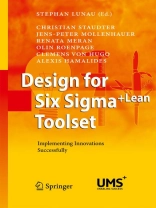Every company relies on innovation to compete globally. However, creative ideas are mostly insufficient if you want to translate an innovative spirit into commercial success. The ability to put a new product or a new process on the market as quickly as possible is becoming increasingly important. Systematic management is necessary for developing cost-effective and successful products based on market realities and customer requirements. Especially open innovation, which is currently intensively discussed and widely implemented, requires consideration. Only a sensible interface and information management is capable of generating overall success from a variety of good ideas. +Lean Design for Six Sigma is an approach for such a systematic innovation management. This concept was developed to achieve a target-oriented realization of innovations and is +Lean strongly associated with the Six Sigma methodology, currently applied globally to opti – +Lean mize existing processes. DFSS synthesizes a number of key factors, including the active integration of employees, customer-oriented development, the reduction of complexity in products and processes, and controlling of innovation in terms of a standardized procedure. The present toolset represents the proven approach UMS takes when putting Design for +Lean Six Sigma into practice. Its individual tools are assigned to the process model Define, Measure, Analyze, Design, and Verify in a clear and manageable structure. This structure can be considered as a red thread and makes it easier to apply the tools in practice and organize an innovative product and process development that is target-oriented and ef- cient.
विषयसूची
Foreword.- Define: Initiating the Project.- Scoping the Project.- Managing the Project.- Measure: Selecting Customers.- Collecting Customer Voices.- Specifying Customer Needs.- Analyze: Identifying Design Concept.- Optimizing Design Concept.- Reviewing the Capability of the Concept.- Design: Develop, Test and Optimize Detailed Design.- Reviewing the Performance Capability for the Target Production.- Developing and Optimizing Lean Process.- Verify: Preparing Implementation.- Implementing the Process.- Handing over the Process.












